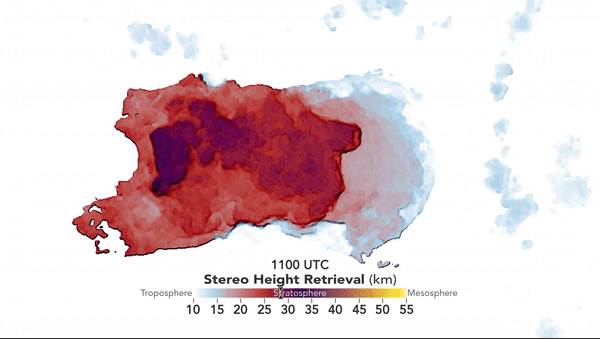On 20 December 2021, Hunga Tonga, a submarine volcano, erupted after nearly seven years of inactivity. The volcano, located in the southern Pacific Ocean, continued exhibiting volcanic activity for a few weeks until Tonga Geological Services declared the volcano dormant on 11 January 2022 after activity on the island decreased. A few days later, 14 January 2022, the volcano once again erupted and on the next day, 15 January 2022, the volcano violently erupted in what was described as a once-in-a-thousand-year event for the Hunga caldera. The massive eruption sent ash over 36 miles into the atmosphere setting a world record in regards to the historical documentation of volcanic eruptions. The eruption produced destructive tsunamis in the Tonga, Fiji, American Somoa, and several other regions around the Pacific rim. Tsunamis also reached as far as the Pacific coast of the US, Chile, Peru, and the Russian Far East.

RGB True Color satellite imagery produced by Himawari-8: Shows massive explosion beginning on 15 January 2022 0410 UTC
The massive eruption of 15 January 2022 produced an ash column that pushed all the way into the mesosphere which is a very rare event. Most volcanic eruptions produce ash columns that top out at the tropopause, an atmospheric boundary separating the troposphere and the stratosphere. This boundary is also where severe, convective weather systems top out as well. This atmospheric boundary layer is usually the cap for most forms of rising air due to the temperature profile of the stratosphere. Unlike the troposphere, temperatures increase with altitude in the stratosphere making it very hard for air to continue rising in this atmospheric layer. Since air rises when it is warmer than the air surrounding it (via buoyancy), it is very hard for air to continue rising in the stratosphere where temperatures rise with height. Due to the high altitudes this eruption’s ash column was able to rise, the volcano was estimated to have ejected an estimated 400,000 tons of sulfur dioxide into the stratosphere. This large quantity of injected sulfur dioxide is expected to have a cooling effect (0.1-0.5 °C) on the entire Southern Hemisphere for months.

GOES-17 Infrared Imagery: Shows extremely cold brightness temperatures of the Hunga Tonga volcanic ash column as the column pushes high into the atmosphere

Stereo Height Retrieval produced by NASA using GOES-17 and Himawari-8 satellites: Using different infrared images from different satellites NASA was able to produce this graphic showing how high the ash column of the Hunga Tonga eruption rose

Ash RGB from GOES-R series satellites: Shows high levels of volcanic ash (red and orange) and sulfur dioxide (yellow) being injected into the atmosphere by the Hunga Tonga eruption
According to preliminary data, the eruption of Hunga Tonga is believed to be the strongest/largest volcanic eruption since the 1991 eruption of Mount Pinatubo. NASA declared the eruption of 15 January 2022 was “hundreds of more times powerful” than the first atomic bomb. Booms from the massive eruption could be heard over 6,000 miles away in Anchorage, Alaska. The eruption produced atmospheric shockwaves that were able to travel around the entire globe. Alterations in pressure (due to pressure waves) were observed in weather stations across the world. The event also produced major levels of lightning which is a result of static electricity produced by colliding particles of volcanic ash. Over 200,000 lightning flashes were recorded in just one hour between 0500-0600 UTC 15 January 2022.

GOES-17 Mid-level Water Vapor Imagery: Shows atmospheric shockwaves propagating around the globe
Large volcanic eruptions, such as the Hunga Tonga eruption, are incredibly powerful events and can lead to devastating consequences across the globe. The eruption of Hunga Tonga injured 18 people and resulted in 5 deaths. Additionally, the event caused an estimated $90.4 million in damages.

